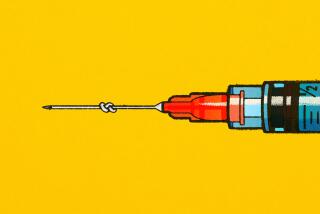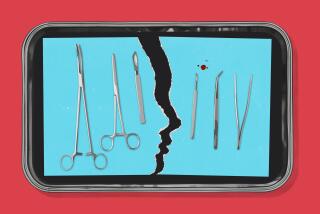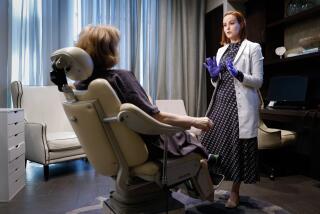Tweaks for Plastic Surgery
- Share via
Plastic surgeons use scalpels, syringes, lasers and chemicals to improve upon nature--but they’re never satisfied. They periodically gather to learn new techniques, trade tips and debate ideals of physical beauty.
This year, at a Las Vegas meeting of the American Society for Aesthetic Plastic Surgery, they talked about fat recycling, face-lift refinements, wrinkle fillers, breast enlargement and, of course, Botox.
For the record:
12:00 a.m. May 23, 2002 For The Record
Los Angeles Times Thursday May 23, 2002 Home Edition Main News Part A Page 2 National Desk 8 inches; 286 words Type of Material: Correction
Physician’s title--In the May 6 Health section, the title of a physician and the name of his institution were incorrect in a story about a plastic surgery meeting. Dr. Stephen A. Goldstein is a clinical instructor at the University of Colorado Health Sciences Center.
*
One of the main side effects of the scowl-eliminating drug, approved for that use last month by the Food and Drug Administration, may be preventable, they learned. Dr. Michael A.C. Kane, a Manhattan plastic surgeon, said that in more than 5,000 cases he was able to avoid or reduce the eyelid-drooping condition called ptosis.
Kane suggested that post-Botox ptosis occurs in people whose eyelids already droop. Most have long compensated by using forehead muscles to keep the eye open; Botox injections simply return it to its natural droopy state. With proper screening of patients, he prevented the effect by injecting less Botox into their forehead muscles.
Some presentations focused on a closely related substance, called Myobloc, as a Botox alternative.
Botox, a potent poison that can be injected to ease forehead lines, crow’s feet, laugh lines and neck bands, comes from botulinum toxin strain A; Myobloc is from strain B. Both temporarily eliminate wrinkles by paralyzing underlying muscles. Myobloc, made by Elan Pharmaceuticals, currently is approved for relief of painfully contracted neck muscles.
A Myobloc injection is quicker to paralyze the muscle, typically within about 12 hours versus a couple of days for Botox. But its effects don’t last as long, according to Dr. Jason N. Pozner, a plastic surgeon from Boca Raton, Fla. Botox works for about three months. Pozner found that Myobloc lasts an average of nine weeks. Because Myobloc is more acidic, it can cause more discomfort.
Among the most intriguing topics at the meeting was the potential of recycling stem cells harvested from patients’ own liposuctioned fat. These cells would be used to create new tissues that could be put back into patients’ bodies during later cosmetic or reconstructive procedures.
With liposuction the world’s most-performed cosmetic surgical procedure, that potential is particularly attractive to doctors who are already, in the words of plastic surgeon Dr. Richard D’Amico of Englewood, N.J., “in the business of harvesting fat.”
In addition, researchers at UCLA, along with colleagues overseas, are looking into ways they might reuse the collagen-rich material that’s suctioned along with the fat. Collagen provides structure to skin and connective tissue.
Some of the fat removed with liposuction also can be used to reshape the face and body.
Plastic surgeons also debated how to get better, more natural results in rejuvenating the face and neck. Some prefer cutting away sagging skin and repositioning underlying tissues and fat; others favor injecting fat and other substances into hollows and lines to restore more youthful contours. Dr. Sydney Coleman, a Manhattan plastic surgeon, suggested that colleagues should think about the potential of the syringe, not just the scalpel, in rejuvenation.
Coleman also drew attention to the few reported cases in which fillers injected into the face had caused blood clots in the eye, resulting in blindness. He suggested these incidents might be prevented with smaller-gauge needles and exerting less pressure when injecting into the face.
Plastic surgeons today increasingly offer their patients noninvasive techniques to improve their looks, including laser and other light treatments that don’t break or burn the skin. These seem to work best at fading redness and discoloration from sun damage. The verdict remains out on their ability to plump and tighten skin.
About a year ago, many plastic surgeons began selling patients a device that uses plastic domes and vacuum suction to increase breast size. Brava hit the market with great fanfare. With an investment of $2,500 and much of users’ leisure time, the device promised to permanently increase a small-breasted woman’s bra size by about an extra cup without surgery.
But while initially promising, the device apparently doesn’t work in many women, even when they faithfully wear it at least 10 weeks as advised, some doctors said.
“I think they went to market too early,” said Dr. Candido E. Fuentes-Felix of Huntington, N.Y., who noted the difficulty in getting an objective measurement of the promised breast enlargement.
Dr. Steven Teitelbaum, a Santa Monica plastic surgeon who sold the device to 20 patients, said most of those women came back dissatisfied. At least two subsequently opted for breast implant surgery.
“After 10, 12 and even 14 weeks, the difference is almost imperceptible,” he said. His only satisfied patients were those who had very loose breasts after breast-feeding or losing a lot of weight, or those who wore it “month after month,” sometimes up to 50 weeks. Thin, athletic women with minimal body fat got no response, he said.
Other physicians defended the device. Dr. Thomas J. Baker, a Florida plastic surgeon who had announced promising results at the group’s meeting two years ago, announced that further study of 125 women, 95 of whom completed a total of 10 to 26 weeks in the device, showed that those who stuck with it got the best results.
Some products had more favorable reports, such as the Ultrasoft lip implant, which may be the first one to pass the “kiss test.” In most people, the soft tubular material under the lip tissue can’t be felt by a partner, even during a passionate kiss. Unlike injectable fat or collagen, which the body eventually absorbs, the Ultrasoft implant lasts indefinitely, yet can be removed.
The lip plumper is a polymer tube about the diameter of a coffee stirrer. It is inserted into the lip through a tiny incision at the corner of the mouth, which is undetectable after it heals. Two or three months after insertion, the person doesn’t notice it, reports William Adams, a researcher studying the implant at the University of Texas Southwestern. And the inert material poses no risk of rejection.
While some doctors prefer the customization that injectable fat and collagen allow, Stephen A. Goldstein, a clinical associate in plastic surgery at the University of Colorado Health Care Sciences in Denver, says, “I think there is a place for both. Some patients like a trial run with one of the injectables before having something more permanent put in.... But the Ultrasoft is easy to remove if the patient decides they don’t like it.”
The meeting also included sessions in which doctors discussed why they no longer use certain techniques. Many said they now do far more limited face-lifts, making shorter incisions and repositioning fat pads to avoid a tight look.
*
Dianne Partie Lange contributed to this report.






